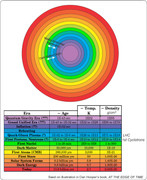As per other's request, here is an installment of some snippets I find intersting from the book I'm enjoying, "At the Edge of Time" by Dan Hooper (Fermi scientist).
He presents a nice illustration of 13 eras that I would replicate but I might need his permission. Do I?
Chapter 1:
After the first 10^-43 sec., gravity may have started to behave as we “know and love”.
But EM, strong and weak force “likely appeared very differently from the way they do today.”
“Then things got weird.” Inflation likely took place at about 10^-32 sec. The universe grew in volume almost instantly by a factor of perhaps 10^75. “...every particle was left in isolation”, and space was once again filled with matter and energy. “Our universe got a new start and a second beginning.”
“After one trillionth of a second, all four of the known forces were in place.” Temperatures were about 10^15 degrees. “Exotic particles like the Higgs boson and top quarks were as common as electrons and photons.”
After a millionth of a second, the lower temperature allowed quarks and gluons to bind together, forming the first protons and neutrons.
After a few minutes, things cooled enough to allow fusion to form atomic nuclei. “During this era, our entire universe resembled the core of a modern star.”
After a few hundred thousand years (380k), electrons combined with these nuclei to form the first atoms.
About 200 million years later came the first stars.
It is still unknown how matter exists when the earliest moments should have produced equal amounts of matter and antimatter, cancelling one another.
What DM is remains a mystery, but “it was almost certainly formed in the first fraction of a second after the Big Bang.”
The inflation period possibly involves dark energy.
Our “universe’s greatest mysteries are firmly tied to its first moments.”
Although many thought the LHC would “lead us to a qualitatively superior understanding of our universe and its origins…the machine has not discovered any of the new particles [except the Higgs boson] or other phenomena that we anticipated.”
He presents a nice illustration of 13 eras that I would replicate but I might need his permission. Do I?
Chapter 1:
After the first 10^-43 sec., gravity may have started to behave as we “know and love”.
But EM, strong and weak force “likely appeared very differently from the way they do today.”
“Then things got weird.” Inflation likely took place at about 10^-32 sec. The universe grew in volume almost instantly by a factor of perhaps 10^75. “...every particle was left in isolation”, and space was once again filled with matter and energy. “Our universe got a new start and a second beginning.”
“After one trillionth of a second, all four of the known forces were in place.” Temperatures were about 10^15 degrees. “Exotic particles like the Higgs boson and top quarks were as common as electrons and photons.”
After a millionth of a second, the lower temperature allowed quarks and gluons to bind together, forming the first protons and neutrons.
After a few minutes, things cooled enough to allow fusion to form atomic nuclei. “During this era, our entire universe resembled the core of a modern star.”
After a few hundred thousand years (380k), electrons combined with these nuclei to form the first atoms.
About 200 million years later came the first stars.
It is still unknown how matter exists when the earliest moments should have produced equal amounts of matter and antimatter, cancelling one another.
What DM is remains a mystery, but “it was almost certainly formed in the first fraction of a second after the Big Bang.”
The inflation period possibly involves dark energy.
Our “universe’s greatest mysteries are firmly tied to its first moments.”
Although many thought the LHC would “lead us to a qualitatively superior understanding of our universe and its origins…the machine has not discovered any of the new particles [except the Higgs boson] or other phenomena that we anticipated.”



